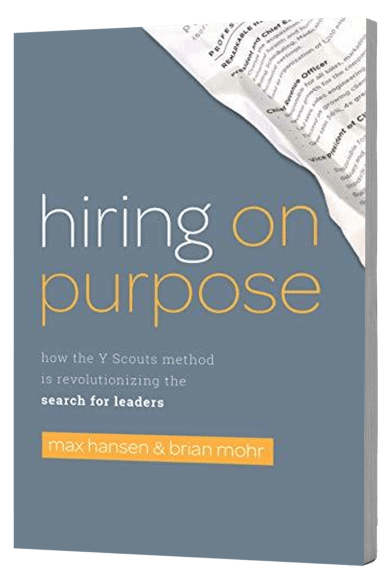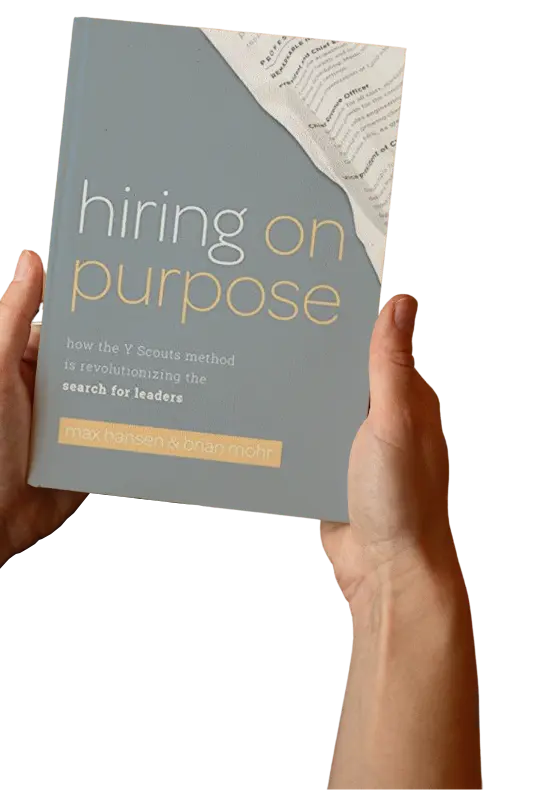With artificial intelligence (AI) getting more effective, technology seems like the future of quick and effective hiring decisions. Algorithms now scan resumes, score candidates, and even predict future performance. But when it comes to leadership hiring, executive search companies and other experts quickly point out that AI just doesn’t cut it.

Table of Contents
ToggleA Place for AI in Recruitment
There’s no denying AI brings value to the hiring process. It can quickly analyze large volumes of data and identify patterns to provide helpful information for your hiring teams. The general place for AI is handling specific, well-defined tasks.
Some examples of how AI can help in the hiring process are:
- Sorting through thousands of candidate profiles for relevant qualifications
- Limiting biases in the early application stage, like blind resume reviews
- Identifying resume inconsistencies or red flags to explore during interviews
- Automating scheduling for interviews and testing
- Analyzing market patterns like compensation and relevant training
- Creating comprehensive job descriptions and onboarding materials
- Identifying hiring issues in the company
Treat AI as a tool to assist in narrowing the field, speeding up the process, highlighting blind spots, and informing hiring decisions from large patterns. Your hiring team will see greater efficiency in the recruitment process.
Executive Hiring is Too Complex
C-level roles are different from general hiring. You’re looking for a leader who can navigate ambiguity, align teams, build trust, adapt to change, and drive innovation. Those qualities don’t always show up neatly in a dataset.
The fit of your executive hire is also more important than in other roles. The candidate you hire will work closely with you to lead your organization, and you can’t afford friction. That fit is hard to figure out in person, much less through an automated hiring process.
The executive recruitment process is different as well. Most positions are posted on job boards and then filled by active applicants. However, you may use a contingency search firm, a retained executive recruiter, or other methods to target passive candidates for C-level positions.
These differences in executive hiring point to the reason AI falls short: the process is too complex. You can still use AI to inform your hiring decisions as long as you understand its limits and make sure to combine it with all-important human-led efforts.
AI Pitfalls
Here’s a closer look at how AI misses the mark when it comes to executive hiring:
AI Misunderstands Experience
One pitfall of relying too heavily on algorithms is that you may filter out candidates with nontraditional experience. AI favors uniformity and penalizes profiles outside the template it is looking for. But conformity in your C-level team is not what your organization needs.
Imagine your venture capital software as a service (SaaS) company is searching for an executive. A candidate with experience in nonprofit leadership could bring a mix of mission-driven focus, scrappy innovation, and people-first leadership to your leadership team. But algorithms struggle to assess unexpected language or atypical job titles as valuable experience. You might miss that candidate if AI does all your screening.
Instead, consider using AI to analyze patterns in your executives and candidates to identify the most relevant qualifications for your new position. Then use an algorithm to draw your attention to those qualities rather than only selecting candidates based on skills. It takes more time than letting AI decide which resumes to keep, but you also miss out on fewer opportunities.
Algorithms Create Gameable Systems
Relying on job descriptions, resumes, profiles, cover letters, and application questions allows people to work the hiring system in general. They can present themselves as a better fit for your organization based on what you are looking for. This system is especially gameable when you rely on hiring algorithms.
You might set up your algorithm based on job description, key performance indicators (KPIs), desired traits, or information about your company. This is likely the same information that you have provided to applicants.
When you set up your algorithm this way, you create a system where the main tool in the hiring process favors people who copy and paste from your publicly available information. Rather than helping you, AI is now providing you with lower-quality candidates, requiring someone else to go back through the process, rewrite the algorithm, and start again.
Especially in executive searches, you don’t want to waste time undoing or redoing the work you thought AI could handle. You need high-quality candidates, not ones who can trick a computer.
Artificial, Not Emotional Intelligence
When hiring for leadership, you’re choosing a co-pilot rather than a vendor. An executive influences morale, decision-making, conflict resolution, and long-term performance. You need an executive with the right leadership dynamics.
How do you define that for AI? No artificial intelligence has the emotional intelligence to understand the nuances of a people-oriented job. Algorithms can try to approximate human judgment using personality assessments, behavior models, quality keywords, and quality definitions, but they will have wildly varying results.
Say the CEO you are hiring will work closely with your shareholders and board of trustees, which requires a decisive and collaborative person to manage the challenging politics. AI might take your leadership definition and over-eliminate candidates who don’t explicitly list certain qualities. That’s where real-life CEO recruiters have an edge. They rely on human judgment to find the right candidate with all the right soft skills.
Use AI to compile information about leadership in your company. It can gather feedback and identify patterns about what your stakeholders, employees, and leadership team need in a C-level hire. But make sure to pair your AI use with oversight from real human beings with real emotional intelligence.
AI Guesses at Culture
Culture fit aligns values, leadership, communication styles, and decision-making approach with your company’s mission and team dynamics. An algorithm can use profiles and assessments to label candidates and guess their fit, but it won’t be able to read between the lines.
For example, your company values autonomy and bold decision-making. AI might recommend an executive with experience in a decision-making role from a high-stakes industry. But if their experience is from a highly structured environment with top-down leadership, that candidate could clash with your core values. An algorithm would never know that from resume keywords or structured interview responses.
Heavily relying on AI for executive hires can also lead to conformity in your organization’s culture. A computer trying to decide if a candidate “fits” the environment is more likely to favor those who match the current leadership, creating a new bias. And when you’re hiring for leadership, diversity within your company culture is essential.
You are the expert on culture fit, and it’s too important to delegate to AI. Use technology to identify inconsistencies in resumes or applications, and save your energy for picking up on signals only a person can recognize.
Elevate the Human Side of an Executive Search
The best leadership hires happen when you combine data with discernment. You use AI to move faster, remain organized, analyze more information, and stay relevant in your industry. Then you bring people into the executive hiring process to make decisions.
Leadership is complex, messy, and ultimately human. Algorithms can’t fully measure it. When you treat AI as a tool, you maintain control over the most important elements of executive hiring and set yourself up to find the right leaders for your company.



